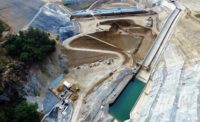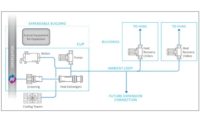 |
| Hard Rock. Good, solid granite has helped tunnelers in Atlanta stay ahead of schedule. (Photo courtesy of Jordon, Jones & Goulding) |
A joint venture team finished boring an 8.3-mile, 18-ft-dia sewage tunnel in Atlanta late last month, hitting a project milestone in a race to comply with a federal sewer overflow remediation consent decree. The work is part of a $3-billion, 14-year program to improve the citys wastewater system.
The Sept. 27 hole-through occurred "on schedule, under budget and we have no claimsthe three nicest things you can say," says construction manager Mike Robison of Jordan, Jones & Goulding, Norcross, Ga. "All the drilling and blasting of the main tunnel and blasting for the connecting tunnels is done." Construction of the $130-million Nancy Creek Tunnel is a joint venture project of Obayashi, San Francisco, and CJB Contracting, Atlanta.
"The tunnel is the linchpin in the citys whole effort to solve its combined sewer overflow problem," says Janet Ward, spokeswoman for the citys Dept. of Watershed Management
|
Work now shifts to lining and grouting. Robison hopes to beat the Dec. 31, 2005, deadline by two months. A pair of Robbins tunnel boring machines cut the tunnels through hard, stable rock in two sections at an average rate of 70 ft per day. "We were close to 100 ft per day at the end," says Tony Gomez, a city spokesman. "We had good, solid granite. Atlanta has good rock for tunnels."
The tunnel fits into the larger program, headed up by a management team of Atlanta-based Khafra Engineering, and Broomfield, Colo.-based Montgomery Watson Harza. Denver-based CH2M Hill Cos. provides management support including project controls that combine all up-to-date project information into a single database. Lawrence Harrod, director of the program management team for the city, says controls provide a high degree of data integration that is changing workflow processes.
"Its the granularity of the data, and the sheer volume of it that has driven a change," says Harrod. "It has streamlined the information flow. Information is being shared among departments and bureaus that were formally very insular."
Pete Bredehoeft, CH2M Hills project controls task manager, says integration is accomplished by "sewing" links between otherwise isolated databases through custom mapping and data warehousing. "The goal is single-source data entry," he says.
Reports and data brought in through one application are automatically passed along to others. For example, daily reports of installed quantities automatically map to accounting that tracks pay requests. "At the end of the month, the pay requests are virtually done because of the daily reports of material installed," says Harrod.



Post a comment to this article
Report Abusive Comment